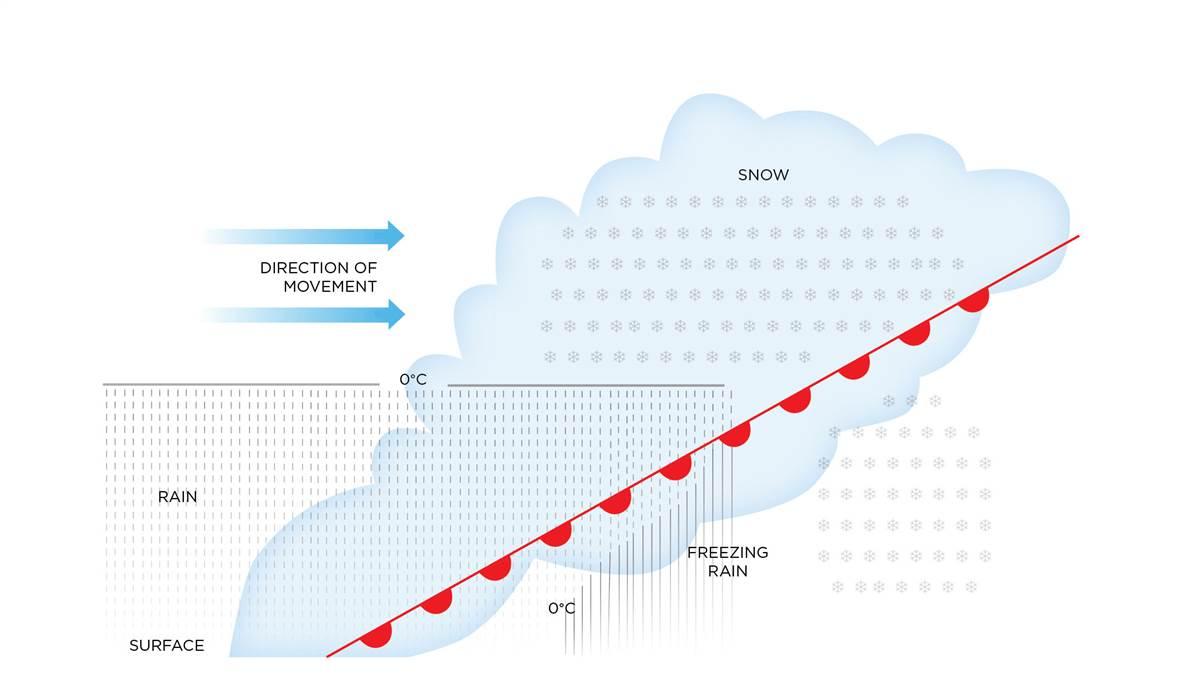Wx Watch: Being ice-aware
Top-line items for winter flying

We have definitions of icing situations based on historical evidence and scientific research, but our experiences in icing conditions sometimes don’t confirm them. One pilot may fly through a band of cloud meeting all the requirements for an icing encounter, yet the airplane remains ice-free. The next pilot to pass through may see a quarter-inch buildup on the wings, tail, and other airframe components. But while this sort of freak event may be possible, we can’t rely on luck when winter weather sets in.
Icing, by the numbers
From our student days, most of us recall that icing is caused by supercooled droplets—which are liquid, yet at a temperature below freezing—and can be encountered whenever aircraft fly in visible moisture (cloud or precipitation) at temperatures between 0 and minus 20 degrees Celsius (32 and minus 14 degrees Fahrenheit). Unsure if it’s fog or visible moisture at your airport? Visibility below one statute mile has been interpreted as visible moisture.
This rather wide temperature band can be divided into two segments. One is for the especially dangerous clear ice, and typically runs from 0 to minus 10 degrees Celsius. Clear ice is bad news because its larger droplets run back after impacting leading edges and accumulate on wings and other airframe components. Any ice accretion will disrupt airflow, raise stall speed, and adversely affect handling characteristics, but clear ice is a winner in this department.
Rime ice is made of smaller droplets that freeze on impact and has a whitish appearance; often it’s seen on leading edges as a thin white line at first—a line that widens and thickens as more ice builds. Rime ice typically forms between minus 10 and minus 20 degrees Celsius.
Mixed icing is a blend of clear and rime accumulations and favors the high end of the clear icing temperature band. Let it build long enough and it can develop double-horn or feathery formations that project forward from leading edges. Needless to say, this really wrecks airflow over the lifting surfaces.

Freezing rain, as well as supercooled large droplet (SLD)—sometimes called supercooled drizzle drop (SCDD) icing—get the trophy for fast-growing, extremely unforgiving ice accretions. Consider this clear icing on steroids, with their droplets so big that they splatter and immediately run aft—even aft of leading edges protected by inflatable deice boots or heated panels—so quickly that loss of control can happen in minutes. This type of icing wasn’t even identified until the October 31, 1994, crash of an American Eagle ATR-72 twin turboprop in Roselawn, Indiana. In brief, the ATR was on autopilot while in a holding pattern. The crew noticed the airplane was flying in a nose-high attitude and lowered the flaps to bring the nose down. The airplane was already in SLD conditions, and the autopilot was already trimming the nose up to prevent a drag-induced loss of altitude. During a descent in the holding pattern, the angle of attack increased, the ailerons deflected, the autopilot automatically disengaged, and the airplane rolled over into a terminal dive.
A climb or descent of as little as 1,000 or 2,000 feet can take you out of an icing zone, if conditions permit.After the Roselawn accident, the NASA Glenn Research Center’s icing research wind tunnel was put to work investigating that day’s icing conditions. The center’s findings, and other accident analyses and simulations, brought about changes. One of them was the development of the Aviation Weather Center’s addition of SLD icing to its Current Icing Potential (CIP) and Forecast Icing Potential (FIP) online forecast products. For more information about this landmark accident, simply Google “Roselawn accident.”
Finding ice
Fronts and low pressure centers, with their large areas of horizontal and vertical coverage, are prime places to find icing conditions. Cold fronts tend to have clouds with high liquid water concentrations, and thus favor clear icing conditions. Warm front cloud masses have smaller droplets, have rime icing, and tend to be layered—but their vast cloud coverage patterns mean that icing conditions could persist for hundreds of miles. An ice-free diversion to an alternate airport may be a long way away.
Geography also plays a part. Airflows over, or originating from, large bodies of water can help boost cloud droplet sizes, liquid water contents, and also create SLD conditions. The Roselawn crash happened near Lake Michigan, and the Great Lakes—along with New England and the Pacific Northwest—are frequent locales for the most dangerous icing conditions.
There are many preflight sources of information on the location and extent of icing. Perhaps the best is the Aviation Weather Center (AWC) website, aviationweather.gov, and its CIP and FIP maps. These assign current and future icing probabilities and identify areas of suspect SLD icing with red stippling. Under “Forecasts,” select the “Icing” drop-down menu, then click on Forecast Icing. The AWC’s Graphical Forecasts for Aviation (GFA) and Flight Path Tool also give icing forecasts—the Flight Path Tool can be configured to show any icing alerts at a range of altitudes along your route of flight. Icing airmets can be called up from the AWC by clicking on the “Advisories” and “G-Airmet” links. For icing pireps, click on “Observations,” then “Aircraft Reps.”
Model-derived forecast Skew-T plots can be used if you want a more detailed look at an atmospheric cross-section. On the Pivotal Weather website, click on any point on the U.S. map and up pops a Skew T—but be sure the model run time is the latest, and valid time is for the time of your flight. Icing conditions are easy to find on a Skew-T. Look for closely spaced temperature (red) and dew point (green) lines. This indicates likely cloud and precipitation; if both lines are below the freezing mark, icing is likely.
Action plans
Once in flight, your prime directive is to avoid clouds and precipitation above the freezing level. Besides your eyeballs, there are several ways to keep you ice-aware, and provide help if need be. FIS-B weather products include icing airmets, Flight Service can identify upcoming areas of icing, and if on an IFR flight plan ATC can provide advice and diversions. If flying under VFR advisories (flight following) ATC can help if workload permits.
Let’s say all has failed, and you’re taking on ice. First off, how do you know? By the time you notice ice on the wings or windshield you may have already lost 10 knots of airspeed and face more accumulation as you carry out an escape plane. That’s why it’s important to watch small-radius airframe parts, like rivet heads, hinges, steps, and struts. These are efficient ice collectors that can give an early warning. Obviously, you’ll also want to keep the outside air temperature reading in your scan. In cloud and below 0 degrees Celsius? Be ready to take action.
How should you fly in icing conditions? Flex the ailerons and elevator to prevent ice formations from freezing them up. If autopilot-equipped, make sure it’s turned off so you can sense changes in control forces, and react accordingly. Change engine rpm and propeller speed from time to time to help keep the propeller free of ice.
Your pitot heat should have been turned on long ago, but if it isn’t, do it now. Using carburetor heat or opening an alternate engine-air door can keep the engine’s air intake and filter from icing up. A climb or descent of as little as 1,000 or 2,000 feet can take you out of an icing zone, if conditions permit. So can a 180-degree turn. Consider landing at a nearby airport.
Climb-or-descend strategies call for caution. You certainly don’t want to climb thousands of feet to on-top conditions; you’d collect more ice and put accretions on the underside of the wings at your climb angle of attack. Likewise, you don’t want to descend into solid instrument conditions all the way to an approach at an alternate airport. You want to lose ice as you descend and maneuver for the landing—not pick more up. But you have a good idea of cloud tops and bases from your preflight briefing, right?
There are two other items to think about: flight into known icing (FIKI) certification, and tailplane stalls. Having inflatable deice boots, propeller heat, windshield heat, and even bleed air-heated leading edges does not constitute blanket inoculation against icing’s adverse effects. This equipment makes for nice tactical avoidance tools, but mill around in light icing conditions long enough, and it can reach severe status. SLD conditions can make even large, powerful, well-quipped, and icing-certified airplanes—like the Roselawn ATR—behave unpredictably, and stall.
As for tailplane stalls, remember that horizontal stabilizers and stabilators have leading edges, too. And their surfaces produce lift—in a downward direction. When they ice up and stall, they lose their downward lift vector, making the tail rise uncontrollably, and pitching the nose downward. Having flaps extended increases the stabilizers’ angles of attack, so the chances of a tail stall are greatest when on final, low to the ground, when the last increment of flaps is selected. That’s one reason to land an iced-up airplane with a limited flap extension.
All this is a lot to ponder. Risking a flight in icing conditions presents a lot of traps—and provides a lot of fodder to contemplate many potential links in an accident chain. This is best done on the ground.
Email [email protected]



